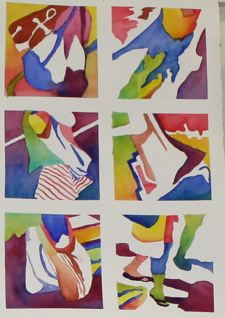![Bathing-on-the-Beach,-1908[1]](/wp-content/uploads/2016/04/Bathing-on-the-Beach-19081.jpg) How do you – or your friends or family – critique your paintings?
How do you – or your friends or family – critique your paintings?
You may want to re-read the November, 2009 posting: Looking at Unfamiliar Art. That addresses how to look at any work of art.. This posting is considering how do we evaluate our work. Or that of our friends?
What is the artist trying to say with the means he or she has chosen to use?
Joaquim Sorolla
 We are all storytellers, or creators of moods (see January 2014 Technique Corner) If there is a language to art, we “talk” with shapes, values and colors. Those are our nouns and verbs, the tools of our language.
We are all storytellers, or creators of moods (see January 2014 Technique Corner) If there is a language to art, we “talk” with shapes, values and colors. Those are our nouns and verbs, the tools of our language.
Let your eyeballs “hang loose.” Let your eyes move through the painting with you directing them. No judgment words are allowed… not now. You are opening yourself to the piece. You are not thinking about your agenda, your preferences but letting the painting lead you.
Ted Nuttall, Caprice
 Ask yourself:
Ask yourself:
- What is this painting about?
- this can be subject matter (boats, children, cityscape)
- this can be theme: sunlight, tranquility, noise and confusion, gaiety
- How is the artist using shapes to convey this subject or theme?
- How is the artist using values?
- How is the artist using color?
- How am I (those loose eyeballs) led through the painting?
- Where is the final or main form — and do I end up there?
- What was the pacing of my visual journey like?
- How do all of these contribute to (or distract from) the emotional or psychological impact of the piece?
- Is there anything in the painting that isn’t contributing?
- Is there anything in the painting that is distracting from the theme or from the visual journey.

Observing these, answering these questions, you can see the things, like an editor, that can made a stronger painting.
Alice Neel, Nancy and Olivia
The answers to these questions are helpful. The real meaning of criticism is to suggest the next step. We have come to think of criticism as meaning negative criticism. Positive criticism is useful, such as “The orange toward the corner is so bright, it pulls my eye away from the subject.”
We have had quite a discussion with no mention so far whether or not we “like” the painting. Let’s look at some that are posted here.
Look at the first two, Sorolla’s mother picking up her child and _______ freight yard. Notice that the colors are almost identical. But the VALUES of those colors are very different.
Why? What is each artist trying to say? How did each use these colors and values to convey what they wished to say?
What would you say each is about? How did each artist say that with their language of shape and value and color?
Between Ted Nuttall’s older woman above and Alice Neel’s mother and child look at the shapes, the values and the colors. Which do you think find shape more a more important component?
Which is enjoying exploring color in light?
What is the emotional message of Alice Neel’s mother and child? How did she use shapes and value and colors to express this?
You can “like” all four of these paintings. But if you do, you like them for very different reasons.
Here are two more:

Butterfly Girl by Amy Dean McKittrick

the chicken is by Morris Graves.
Don’t say which you “like” or don’t like. Just use them to go down the list above.
Did you find that there are no random choices? That in each case: shapes, value, color, everything is contributing. Notice the way you are directed through: the values and colors shift continuously and seamlessly in the Butterfly Girl. Edge (shape) is lost to value and color shifts. Graves bounces you around. How does this contribute to the emotional impact ?
How about Sally Mitchell’s painting – below:

Sally Mitchel, Market Day
The way you think/talk about a painting WITHOUT a subjective thumbs up or thumbs down, is helpful to the artist –your friend or colleague or you.
Some other helpful suggestions for you.
- Walk away. Do this frequently. If you sit, make yourself GET UP and walk away – at least every 20 minutes. Relax your eyes as well as your body.
- Put the painting up (vertical) where you can see it when you come back and leave the room.
- Clear your head of the painting. You can put on a load of wash or return a phone call. Or if you are at a studio, just go outside for a few minutes.
- Come in with fresh eyes and walk toward the painting. Let the painting speak to you.
- Only work when you know what you are going to do next. If you hear yourself thinking you don’t know what to do next. Stop. Leave. Or work on another painting.
- Write out the question. This prompts your subconscious.
- When you know what to do next just do that. Then stop. Get back. See how it looks and where you go from there.
- Ask yourself the list of questions above.
- Stuck. Leave it alone for a while. Or draw it up again and try it a different way. Then go back to the earlier one.
Finally, with any work of art — do you like it? Does it move you? That is the bottom line. There is an emotional connection to a good work of art that defies words. Drink it in through your eyes. IT IS VISUAL ART.
Happy painting. As always, I enjoy your comments.
Caroline
©2014, Caroline Buchanan
